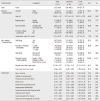Abstract
Methods
This study was carried out as a secondary analysis of data from the 2010 Graduates Occupational Mobility Survey (GOMS). A total of 323 nurses were selected for analysis concerning reasons for turnover. Data were analyzed using descriptive statistics and multilevel survival analysis.
Figures and Tables
References
1. OECD. Health care resources: nursing graduates [Internet]. Seoul: OECD;2012. cited 2015 May 17. Available from: https://data.oecd.org/healthres/nursing-graduates.htm#indicatorchart.
2. Yoon HK, Choi J, Lee EY, Lee H, Park M. Effects of decision making competency, nursing professionalism, and job satisfaction on turnover impulse among nurses. J Korean Acad Nurs Adm. 2013; 19(5):658–667. DOI: 10.11111/jkana.2013.19.5.658.
3. Jeong EJ, Chae GS, Noh WJ, Park MM, Cho UY, Kim HJ. A survey on hospital nursing staffing. Business report for Hospital Nurses Association. Seoul: Hospital Nurses Association;2013.
4. Hayes LJ, O'Brien-Pallas L, Duffield C, Shamian J, Buchan J, Hughes F, et al. Nurse turnover: a literature review–an update. Int J Nurs Stud. 2012; 49(7):887–905. DOI: 10.1016/j.ijnurstu.2011.10.001.
5. Jones CB. Revisiting nurse turnover costs: Adjusting for inflation. J Nurs Adm. 2008; 38(1):11–18. DOI: 10.1097/01.NNA.0000295636.03216.6f.
6. Cho HK, Lee TY, Kim CW. Hospital nurse turnover rate and structural characteristics of hospital. J Korea Acad Ind Coop Soc. 2015; 16(1):453–461. DOI: 10.5762/KAIS.2015.16.1.453.
7. Zeytinoglu IU, Denton M, Davies S, Baumann A, Blythe J, Boos L. Deteriorated external work environment, heavy workload and nurses' job satisfaction and turnover intention. Can Public Policy. 2007; 33(1):S31–S47. http://www.jstor.org/stable/30032503.
8. Han SS, Sohn IS, Kim NE. New nurse turnover intention and influencing factors. J Korean Acad Nurs. 2009; 39(6):878–887. DOI: 10.4040/jkan.2009.39.6.878.
9. Hwang YS, Kang KH. Factors influencing nurse turnover intention in small and medium sized hospitals in the metropolitan area. J Korean Acad Nurs Adm. 2014; 20(5):576–586. DOI: 10.11111/jkana.2014.20.5.576.
10. Lee YJ, Kim KB. Experiences of nurse turnover. J Korean Acad Nurs. 2008; 38(2):248–257.
11. Kim KM, Yim JY, Kim EJ, Lee YM, Hwang MH, Jang JH, et al. The attitude typology of new nurse to turnover: Q methodological approach. J Hum Subj. 2011; 23:163–182.
12. Cho SH, Lee JY, Mark BA, Yun SC. Turnover of new graduate nurses in their first job using survival analysis. J Nurs Scholarsh. 2012; 44(1):63–70. DOI: 10.1111/j.1547-5069.2011.01428.x.
13. Cho SH, Lee JY, Mark BA, Lee HY. Geographical imbalances: migration patterns of new graduate nurses and factors related to working in non-metropolitan hospitals. J Korean Acad Nurs. 2012; 42(7):1019–1026. DOI: 10.4040/jkan.2012.42.7.1019.
14. Cho SH, Lee JY, Mark BA, Jones CB. Geographic mobility of Korean new graduate nurses from their first to subsequent jobs and metropolitan-nonmetropolitan differences in their job satisfaction. Nurs Outlook. 2014; 62(1):22–28. DOI: 10.1016/j.outlook.2013.09.001.
15. Daouk-Öyry L, Anouze AL, Otaki F, Dumit NY, Osman I. The JOINT model of nurse absenteeism and turnover: a systematic review. Int J Nurs Stud. 2014; 51(1):93–110.
16. Locke EA. The nature and causes of job satisfaction. Chicago: Rand McNally;1976. p. 1297–1349.
17. Park JG, Jang SJ, Lee TY. Public health statistics using SPSS 17.0. Seoul: Gyechuk Munwhasa;2010. p. 206–207.
18. Snijders TAB, Bosker RJ. Multilevel analysis: An introduction to basic and advanced multilevel modeling. London: Sage;1999. p. 1–2.
19. Bickel R. Multilevel analysis for applied research: It's just regression. New York: Guilford Press;2007. 07.
20. Kovner CT, Brewer CS, Fatehi F, Jun J. What does nurse turnover rate mean and what is the rate? . Policy Polit Nurs Pract. 2014; 15(3-4):64–71. DOI: 10.1177/1527154414547953.
21. Suh Y, Lee K. Lived experiences of new graduate nurses. J Korean Acad Nurs Adm. 2013; 19(2):227–227. DOI: 10.11111/jkana.2013.19.2.227.
22. Han SS, Moon SJ, Yun EK. Empowerment, job satisfaction, and organizational commitment: comparison of permanent and temporary nurses in Korea. Appl Nurs Res. 2009; 22(4):e15–e20. DOI: 10.1016/j.apnr.2009.06.004.
23. Kim WO, Moon SJ, Han SS. Contingent nurses' burnout and influencing factors. J Korean Acad Nurs. 2010; 40(6):882–891. DOI: 10.4040/jkan.2010.40.6.882.
24. Kang KN. Factors influencing turnover intention of nurses in small-medium sized hospitals. J Korean Acad Nurs Adm. 2012; 18(2):155–165.
25. Bloom JR, Alexander JA, Nuchols BA. The effect of the social organization of work on the voluntary turnover rate of hospital nurses in the United States. Soc Sci Med. 1992; 34(12):1413–1424.
26. Kim YM, Kang YS. The relationship among career plateau, selfefficacy, job embeddedness and turnover intention of nurses in small and medium sized hospitals. J Korea Acad Ind Coop Soc. 2013; 14(10):5078–5090. DOI: 10.5762/KAIS.2013.14.10.5078.
27. Kim Y, Lee JY, Kang H. Impact of nurse, nurses' aid staffing and turnover rate on inpatient health outcomes in long term care hospitals. J Korean Acad Nurs. 2014; 44(1):21–30. DOI: 10.4040/jkan.2014.44.1.21.
28. Lee T, Kang KH, Ko YK, Cho SH, Kim EY. Issues and challenges of nurse workforce policy: A critical review and implication. J Korean Acad Nurs Adm. 2014; 20(1):106–116.
29. Jang JY. Why is the salary of doctors in Ulsan twice higher than that of doctors in Seoul?[Internet]. The Korea Joongang Daily;cited 2016 July 18. Available from: http://news.joins.com/article/20320460.
30. Ministry of Health and Welfare. 2016 nursing care integrated services guideline. [Internet]. Seoul: Ministry of Health and Welfare;2016. cited 2016 July 25. Available from: http://www.nhis.or.kr/bbs7/boards/B0040/18240.




 PDF
PDF ePub
ePub Citation
Citation Print
Print






 XML Download
XML Download